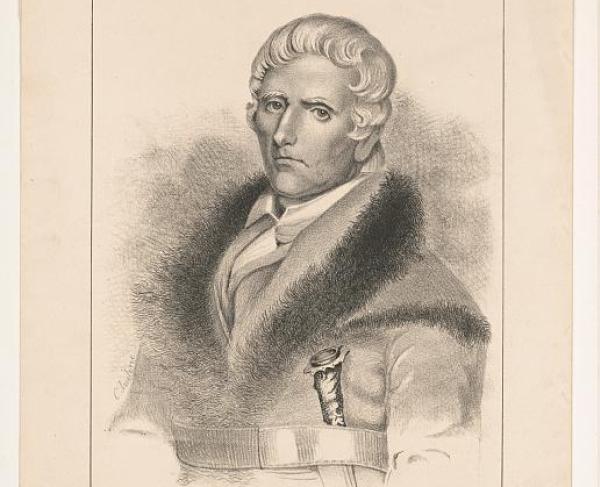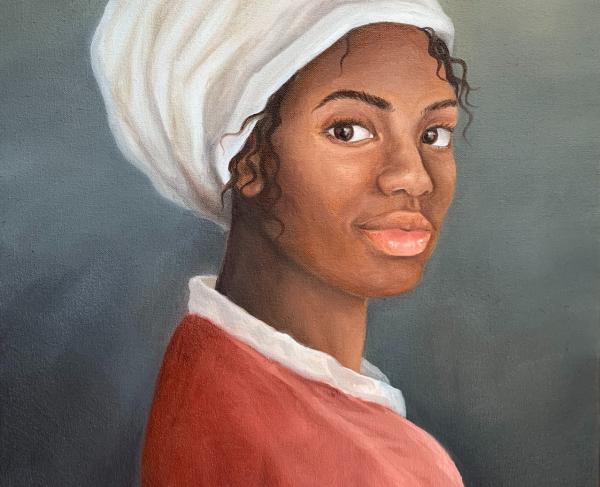Daniel Boone

No name looms larger in the story of the early American West than Daniel Boone. A wanderer for most of his life, he is forever associated with the exploration of Kentucky. Boone’s exploits in exploring and hunting in the Bluegrass, as well as its defense during the American Revolution made him a legend in his own time.
Born on November 2, 1734 Daniel Boone grew up in Oley Township northwest of Philadelphia. As a young man, he spent many hours alone in the forest where he developed and refined the skills that one day would make him famous. At the age of fifteen, he left Pennsylvania with his family following a break with the Society of Friends (better known as the Quakers). Boone resided for about a year in Virginia’s Shenandoah Valley before he finally settled along the Yadkin River in North Carolina.
Rather than take up a life of farming, Boone preferred to make his living as a marker or long hunter. Ranging far from home for months and sometimes years at a time, these individuals relied on the money from the sale of deerskins collected on their hunts to support themselves and their families.
In the spring of 1755, Boone returned to Pennsylvania as a wagoner on Maj. Gen. Edward Braddock’s expedition to Fort Duquesne. During the march, he met a trader named John Findley who regaled him with tales of a veritable Eden west of the Allegheny Mountains, Kentucky. This relatively untouched land was populated by deer, buffalo, elk and other game which presented a significant financial opportunity. Fortunately, both men survived the ensuing ambush and defeat of Braddock’s command.
After a brief courtship, Boone married Rebecca Bryan on August 14, 1756. Their marriage spanned more than half a century and produced ten children, despite Boone’s long absences. In the ensuing years Boone’s hunting took him throughout the Carolinas and south to Florida.
Sometime in early 1769, John Findley appeared at the Boone cabin. His visit rekindled Daniel’s interest in exploring Kentucky. Along with Findley and several others, Boone set out to find his promised land. Boone’s party traveled from the Upper Yadkin Valley to part of what became Tennessee, Virginia and through the Cumberland Gap. On June 7, Boone climbed an eminence later known as Pilot Knob and caught his first sight of Kentucky. He spent the next two years hunting and exploring the wilderness, going as far as the Falls of the Ohio River. He did not return home until May 1771.
In the summer of 1773, Boone led settlers west to permanently settle Kentucky. While traveling through Powell’s Valley in southwestern Virginia, a small group traveling behind the main party were ambushed by Delaware, Shawnee and Cherokee warriors. Among those killed were Boone’s oldest son, James. The tragedy prompted Boone to abandon the effort.
Another opportunity, however, came in March 1775. Judge Richard Henderson, along with other business associates had formed the Transylvania Company. Their goal was to buy Kentucky from the Cherokees. Henderson enlisted Boone’s help to assemble tribal leaders at Sycamore Shoals on the Watauga River. The negotiations resulted in the Cherokees signing over their claims to Henderson, who directed Boone to cut a road through the mountains to allow for the passage of settlers. Heading a band of axmen, Boone cleared a path that would later become part of the Wilderness Road. Boone’s party stopped near a salt lick along the Kentucky River on April 6. There, he established a small fort to which he gave his name, Boonesborough.
Thirteen days later in far away Massachusetts, Minutemen clashed with British infantry at Lexington and Concord. The battles ignited the American Revolution, which soon spread westward as the Crown hoped to maintain control over the Ohio River Valley. With many of its troops committed to the colonies, the British had to rely on the assistance of allied Indian tribes to engage American settlers.
On July 14, 1776, Boone’s daughter Jemima, along with Fanny and Betsy Callaway were abducted by a group of Indians while canoeing along the Kentucky River. Boone, along with several others, immediately set out in pursuit. Picking up the kidnappers’ trail, Boone and his men overtook the party and successfully rescued the girls. This episode would eventually be immortalized by author James Fenimore Cooper in The Last of the Mohicans.
As 1777 opened, the British stepped up their raids in Kentucky. Their operations were directed at the destruction of crops and livestock in order to force the abandonment of the settlements. Boone himself was shot in the ankle during an April raid on Boonesborough. Although the bullet was extracted, he was disabled for several weeks.
The following February, Boone led a contingent to boil salt at the Blue Licks along the Licking River. While out hunting, he was overtaken and captured by a large party of Shawnees. Led by the war chief Black Fish, they were headed to attack Boonesborough. Boone reverted to diplomacy and was able managed to arrange the surrender of the men in order to delay the assault. The ploy worked and the Shawnees took Boone and the salt boilers north to their towns above the Ohio River. Many were adopted by the Shawnees, including Boone who became Black Fish’s son. Boone managed to escape in the middle of June and made his way back to Boonesborough.
Black Fish, at the head of 400 warriors surrounded Boonesborough on the morning of September 7, 1778. Boone had only 60 men to face the onslaught. After negotiations broke down, the siege commenced. Both sides exchanged fire at long range and the Shawnees even attempted to tunnel into the fort. The engagement lasted for nine days and miraculously, the Americans were able to hold on. Unable to capture the fort, Black Fish retired to the Ohio River.
For the next three years, Boone hunted and served as a representative in the Virginia Legislature. Despite the surrender of Lord Charles Cornwallis’ army at Yorktown in October 1781, raids by Shawnees and Great Lakes tribes continued. In the middle of August 1782 Boone headed a party to relieve Bryan’s Station which had been attacked by a combined Loyalist and Indian force under British Capt. William Caldwell. At the head of about 180 militia, including Boone, Col. John Todd set off in pursuit of Caldwell. Early on the morning of August 19, Todd attacked Caldwell on a ridge overlooking the Licking River at the Blue Licks. In a battle of just fifteen minutes, Caldwell managed to set the Kentuckians to flight and inflicted over 50% casualties. Among them was Boone’s son, Israel.
In the summer of 1783, Boone was interviewed by John Filson, an itinerant schoolteacher from Pennsylvania. Embellished by Filson, he turned his notes into The Adventures of Col. Daniel Boone, which appeared as an appendix in The Discovery, Settlement and Present State of Kentucke. Distributed across the country and in Europe, its publication was extremely popular and brought international attention to Boone’s life.
Despite this newfound fame, Boone struggled to make a living. Now over fifty, he attempted to provide for his family as a surveyor, merchant and tavern keeper. Unable to make ends meet and with creditors closing in, Boone decided to leave Kentucky for good in 1799 and move to the Spanish Territory of Missouri.
The Spanish were pleased to have someone of Boone’s stature in Missouri. Authorities gave him a land grant and made him a syndic. Although his eyesight steadily deteriorated, Boone still enjoyed the hunt, venturing still farther west and north up the Missouri River. What land he acquired was sold to pay off his debts in Kentucky. On March 18, 1813, Rebecca tragically passed away.
As he grew older, he was visited by travelers and passersby who just wanted to say they had met and spoken with the pioneer. When asked about his life by one individual, Boone replied “Many heroic actions and chivalrous adventures are related of me which only exist in the regions of fancy. With me the world has taken great liberties, and yet I have been but a common man.” Boone died on September 26, 1820. He is buried with Rebecca in Frankfort, Kentucky
Related Battles
83
17

